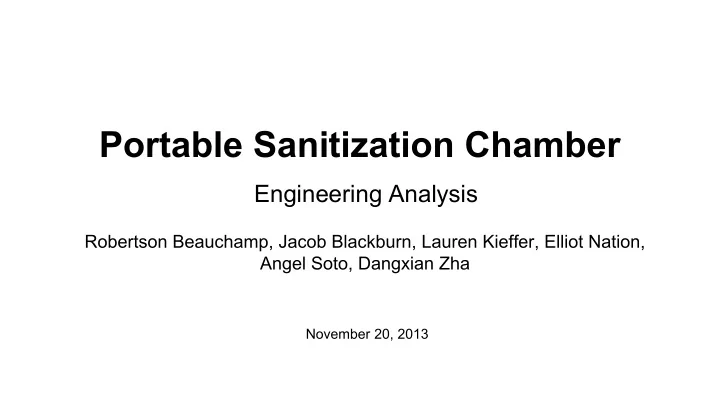

Portable Sanitization Chamber Engineering Analysis Robertson Beauchamp, Jacob Blackburn, Lauren Kieffer, Elliot Nation, Angel Soto, Dangxian Zha November 20, 2013
Overview ● Introduction ● Designs and Analyzations ○ UV Light ○ Chemical Spray ○ Lasers ● Conclusion Angel Soto 1
Introduction ● W.L. Gore & Associates ● Develop a portable sanitization process that decreases the bioburden levels on select materials to a certain threshold. ● Five Concepts ● Possibly combine processes Angel Soto 2
Design Specifications 3 Angel Soto
Chemical Fogging ● 7% hydrogen peroxide (H 2 O 2 ) solution ● Cold vapor safe for materials sensitive to heat and water ● Filters must be used to break down H 2 O 2 Lauren Kieffer 4
Chemical Fogging Design Filter placement Fog unit Lauren Kieffer 5
Filters ● HEPA filters- useless for chemical breakdown. ● Activated Carbon filters- break down some chemicals, need to be replaced often. TiO 2 -photocatalytic oxidation using UV light, breaks down ● chemicals and bacteria. Lauren Kieffer Photo courtesy of: www.peakpureaire.com 6
Material Selection ● Must be compatible with H 2 O 2 at various concentrations. ● Aluminum, PVC and PTFE - No negative reactions ● Aluminum used for enclosure, door, handles, hinges, etc. ● PVC and PTFE used in fogging components, tubing and nozzle. Lauren Kieffer 7
Ultraviolet Germicidal Irradiation Jacob Blackburn 8
Ultraviolet Germicidal Irradiation Jacob Blackburn 9
Ultraviolet 3D Model Jacob Blackburn 10
UV-C Laser ● Still in development ○ only able to produce 1 mW continuous beam ● Use a bare aluminum Mirror to direct laser beam ○ no less than 90% reflectivity ● 1 mW beam needs only 0.095 secs to sterilize the area under beam ○ sounds fast, but if beam size is .05 cm diameter... Robertson Beauchamp 11
UV-C laser (1mW and 100mW) 1 mW laser ( time to scan 8.5” x 11” area) 100 mW laser Robertson Beauchamp 12
Combined UV/H 2 O 2 Process ● Eliminates need for filter ● Creates free hydroxyl radicals, OH+, that are strong oxidizing agents. ● Radicals degrade additional toxins. ● Study shown this process inactivates Bacillus atrophaeus spores. Elli Nation 13
Material Selections ● Aluminum used for enclosure. ● PVC and PTFE used in fogging device. ● Borosilicate glass used in between enclosure and UV lights. ● High UV transmittance, protects bulbs from fog and dust. Elli Nation 14
Mass Calculation for Combined UV/H2O2 Process Dangxian Zha 15
Total Mass of the Chamber Dangxian Zha 16
Project Plan Angel Soto 17
Conclusion ● UV Light and Chemical processes compliment each other ● The two concepts work better together than separately for what we need Angel Soto 18
References [ 1]Peak Pure Air, “How TiO2 UV Photocatalytic Oxidation (PCO) Works” , 2001, https://www.peakpureair.com/how-tio2-uv- photocatalytic-oxidation-pco-works, accessed on Nov. 14, 2013. [2]Melanie Kito, Hi Nguyen, and John Tran, “Hydrogen Peroxide and UV Treatment”, 1998, http://www.calpoly. edu/~ceenve/enve/jsczechowski/enve436/projects/Hydro-Perox/H2O2-UV-Treatment.html, accessed on Nov. 12, 2013. [3]Braz. J. Chem. Eng. vol.30 no.3 São Paulo July/Sept. 2013, “Inactivation of Bacillus atrophaeus spores in healthcare waste by UV light coupled with H 2 O 2 ”, 2012 [4]Cole Parmer, “Material Compatibility with Hydrogen Peroxide (H 2 O 2 )”, Ozone Services, http://www.ozoneservices. com/articles/004.htm, accessed on Nov. 14, 2013. [5]Schott North America, Inc., “SCHOTT Tubing Product Selector”, 2013, http://www.us.schott. com/tubing/english/product_selector/index.html?glassid=8347, accessed on Nov. 16, 2013 [6] Owens,M., Deal,D., Shoemaker, M., Knudson, G., Meszaros, J., and Deal, J., 2005, “High-Dose Ultraviolet C Light Inactivates Spores of Bacillus Atrophaeus and Bacillus Anthracis Sterne on Nonreflective Surfaces,” Applied Biosafety, 10 (4) , pp. 240-247. [7] Boardman, E., Huang, L., Robson-Hemmings, J., Smeeton, T., Hooper, S., Heffernan, J., 2012, “Deep ultraviolet (UVC) laser for sterilisation and fluorescence applications,” Sharp Laboratories of Europe, Ltd.
Recommend
More recommend